Uncategorized
Steven Salen, a tailor who survived the Holocaust and dressed presidents, dies at 103
NEW YORK — (JTA) — Nothing riled Steven Salen like a powerful man in a bad suit.
“‘That suit fits terribly!’” his daughter Elayne Landau recalled him as yelling at the TV, multiple times. “‘How’s he going to get elected? Elayne, send him a letter.’ He would dictate the letter. ‘I’m watching you on television. That suit fits horribly. You really look like you’re one-sided. Come see me!’
Sometimes, Landau recalled in an interview, she would even send the letter. And a couple of times there was a polite and friendly reply.
Salen, 103, died on Nov. 23 at a hospital in Manhasset, New York. He was a Holocaust survivor, a savvy war-era black marketeer, and then once landing New York, he built up a reputation as an outfitter — a “bespoke tailor,” as his family put it — to the powerful and influential, working until he was 95.
Salen loved talking about the opportunities this country gave him, but like many survivors, he didn’t begin to open up about the horrors he witnessed and suffered until late in his life — in his case, in his 90s.
He enjoyed regaling his children and grandchildren about his clients and what he designed to make them look good, recalled his granddaughter, Rachel Landau Fisher. One time, he saw an old photo of a man on a tarmac in a trim gray overcoat. Salen said he had made the coat.
The photo was of President Richard Nixon shaking hands with Chinese premier Zhou Enlai in Beijing, the launch of a history-shaking visit that thawed U.S.-China ties.
President Richard Nixon shaking hands with Chou EnLai while wearing a coat that Steven Salen told his family he’d made, Feb. 21, 1972. (U.S. National Archives)
“His grandchildren, Jake, Sofia, Rachel and Sam enjoyed his many stories, including a favorite of a Mafia client walking in on FBI Director J. Edgar Hoover in his underwear during a fitting,” his granddaughter, Landau Fisher, wrote in a remembrance.
At his home in Bayside, Queens, he kept mementos of his career: Handwritten entries in ledgers spanning decades, including names like Nixon, and his secretary of state, Henry Kissinger. A framed 1980 check from former President Gerald Ford for $3,170. Gerald Ford tie clips. A hardcover and pristine copy of Kissinger’s remembrance, “White House Years,” with an inscription, “To Steve Salen, who makes me look almost presentable.” A client list from 2000 that includes names like Hearst and Scorcese.
“Martin Scorsese was one of his last clients,” Elayne Landau said of the film director. “So was Harvey Keitel.”
Salen was an old-school, word-of-mouth tailor who started working at FL Dunn on Fifth Avenue in New York, and eventually had his own full-floor atelier on Madison Avenue and 53rd Street, at the heart of the city’s high-fashion district.
In 2011, when Salen already topped 90, the New York style blog “The Trad” profiled his shop. It began, “Back in the ’50s, there were 300-400 bespoke tailors in NYC. Today — there might be 30.”
“They don’t have a web site. They sure as hell don’t have any marketing savvy. Steven can’t even figure out his phone. But they can build you a suit. In fact, they build suits for a lotta shops in NYC who claim to build their own,” the blog reported. “You get chalked up. And then what? Where does your suit go? China? Mexico? Turkey? Or, to the 11th floor of an office building in midtown Manhattan.” (“It ain’t cheap,” the blogger advises.)
Occasionally Salen would pop up in an aside in an article about the rarefied occupants of New York’s social stratosphere, as when the New York Times Magazine profiled antiquarians Leigh and Leslie Keno in 1986 (they are now famed as appraisers on PBS’s “Antiques Road Show”).
“After years of searching for the perfect tailor, they finally found one they feel meets their specifications, a man named Steven Salen,” the Times said. “He passed the brothers’ acid test for tailors by spotting immediately that each twin has an arm that’s a quarter of an inch longer than the other.”
Steve Salen at his granddaughter Rachel Landau’s wedding in 2020. (Family)
Salen would not tell his children about his life before his arrival in the United States unless he had to explain the marks his suffering had left on his body.
“He told the story of how, to his amazement, he twisted off his frozen toes and didn’t even feel it,” Elayne Landau wrote in a eulogy, describing the time her father spent on the Russian front as a slave of the Nazi war machine. “We had seen his feet, you see, so he had to say something about that.”
“He was a Holocaust survivor, but as much as that experience shaped who he was, he did not want to be defined by it,” she wrote. “I understood this because growing up in a community of refugees, we didn’t ask these questions and for the most part, people didn’t offer. People needed to move on.”
He worked ceaselessly, Landau said in the interview. “I remember on Sundays we used to go to Schwartzbaum, which was a woolen shop on the Lower East Side on Delancey street to buy cloth, so this was a seven-day-a-week thing for him,” she said.
And then, in his 90s he began to open up, and Elayne Landau saw an opportunity to get close to the father who spent her childhood working.
“He remarked frequently that he can’t believe he made it,” she wrote in her eulogy. “And he began to want to talk about it. Sadly, by this time, well into his 90s, he could not recall many specifics. But with the help of the few reminiscences that I’d written down through the years, Rachel and I were able to piece together the outlines of his story.”
He was born Zoltan Salomon in Nelipyno, Czechoslovakia in 1919. In 1939, in what he would later describe as some of the best years of his life, he was learning tailoring at a trade school run by the American Jewish Joint Distribution Committee.
Then the Nazis arrived and they deported Salen. He never saw his parents or seven of his 11 siblings again. Russians liberated him in 1943. “He told me how the Russian soldiers gave the Jews guns to shoot their German captors,” Elayne Landau recalled. “He said some people did.”
He joined the Czechoslovakian army and became a supply sergeant, which required sharp business skills to negotiate the black market. A fellow black marketeer had a cousin, Frantisca, who was 18; she and Salen were married within three weeks. They arrived in New York in 1949, and Salen landed a job as a tailor almost immediately.
His wife, who took the American name Frances, predeceased him, and so did his son, Jeff, a founder of the seminal 1970s punk band, Tuff Darts, who died of a heart attack in 2008. He is survived by his daughter, Elayne, son-in-law Matthew Landau, daughter-in-law Diana Salen and his four grandchildren.
“He really wanted to be defined by his American life,” Elayne Landau said. “He was so grateful for being here you could never say anything bad about against America.”
His granddaughter, Rachel Landau Fisher, said he and her grandmother drew slightly different pleasures from their American experience.
“He and his wife were most honored to have tea with First Lady Betty Ford after fitting the president at the White House,” she said. “His happiest place was at a poker table in the Catskills’ Concord Hotel.”
—
The post Steven Salen, a tailor who survived the Holocaust and dressed presidents, dies at 103 appeared first on Jewish Telegraphic Agency.
Uncategorized
The Iranian People Are Demanding Their Freedom; Where Is the Media?

Protesters demonstrate against poor economic conditions in Tehran, Iran, with some shopkeepers closing their stores on Dec. 29, 2025, in response to ongoing hardships and fluctuations in the national currency. Photo: ZUMA Press Wire via Reuters Connect
“What were the media doing when the regime led by Ali Khamenei finally fell?”
That is the question that will be asked if, as many Iranians now dare to hope, we are witnessing the final days of the Islamic Republic after more than four decades in power. It is also a question the Western press may struggle to answer.
How It Started
The current wave of unrest began in late December, when shopkeepers in Tehran went on strike amid growing fury over Iran’s collapsing economy. The rial hit record lows, while prices continued to soar under crippling inflation. Traders, wholesalers, and merchants took to the streets in protest, initially over economic mismanagement — but anger quickly turned toward the regime itself.
Within 48 hours, demonstrations had spread beyond the capital to major cities including Isfahan, Shiraz, Mashhad, Hamadan, Qeshm, and beyond. Videos posted by Iranians showed crowds chanting explicitly political slogans: “Death to the dictator,” “Mullahs must go,” and “This homeland will not be free until the mullah is gone.”
Iranian state-affiliated media have acknowledged several deaths. Independent estimates suggest the toll may be significantly higher. What is not in dispute is that the unrest has rapidly evolved from economic protest into a broad-based challenge to clerical rule.
The Story the Media Barely Told
And yet, on Friday, The New York Times ran not a single front-page story on the protests.
Not one.
This was unrest that — if it succeeds — could reshape Iran, the Middle East, and global security dynamics for decades. A regime that backs Hamas and Hezbollah, arms terrorist proxies across the region, threatens Israel’s destruction, and destabilizes international energy markets was facing its most sustained nationwide dissent in years. Still, the story barely registered.
The New York Times’ near silence was not an outlier. It was emblematic.
When the lack of coverage was challenged on social media, John Simpson, World Affairs Editor at the BBC, offered an almost comical defense: social media videos, he said, must be carefully verified before “reputable outlets” can use them.
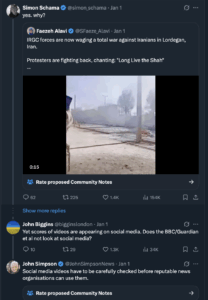
That principle, in isolation, is uncontroversial. But its selective application is not.
This is the same BBC that has repeatedly broadcast unverified — or lightly verified — footage and photographs from Gaza. In Iran, however, verification suddenly became an insurmountable obstacle, even as dozens of videos from multiple cities showed consistent scenes, slogans, and patterns of unrest.
When Framing Does the Regime’s Work
Reports by the BBC and analyses from BBC Verify have repeatedly emphasized “cost-of-living protests,” despite verified footage of crowds chanting for the end of clerical rule and attacking regime symbols.
Where BBC Verify has undertaken the “verification” John Simpson said was so difficult, it has drawn criticism for focusing on debunking isolated instances of AI-generated imagery — rather than acknowledging the overwhelming volume of genuine footage documenting brutality against protesters.
Genuinely shocked to see BBC Verify have chosen now to be out there giving an impression we should not believe what we are seeing in #Iran based on one image (of a real event).
Amplification of this intensely organic revolution by Israeli social media accounts is making many…
— Omid Djalili (@omid9) January 2, 2026
Sky News, Reuters, FRANCE24, and others followed a similar pattern — leading with rising prices and economic stagnation while giving little attention to the unmistakably political slogans echoing through Iranian streets.
This framing matters. Protests about inflation suggest reform. Protests calling for the removal of the Supreme Leader suggest regime collapse.
In some cases, Western coverage has gone further, adopting the regime’s preferred framing outright.
When President Donald Trump warned that the United States would respond if Iranian protesters were massacred, Iranian officials condemned the remarks as “reckless.” Several outlets, including the BBC, led with that condemnation, centering Tehran’s outrage and implicitly casting the United States, rather than the Islamic Republic, as the destabilizing force.
Last week, The Guardian even published an opinion piece by Iran’s foreign minister, Abbas Araghchi, under the headline: “You’ll never defeat us in Iran, President Trump: but with real talks, we can both win.”
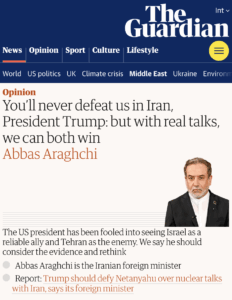
Put simply, this was The Guardian lending its pages to the propaganda of a senior official from the very regime Iranians are risking their lives to oppose — the same Islamic Republic that beat Mahsa Amini to death for allegedly wearing her hijab incorrectly, executed protesters, imprisoned dissidents, and ruled through fear for 45 years.
1/
Western media coverage of Iran’s escalating nationwide protests has been strikingly limited and cautious – despite widespread anti-regime demands across dozens of cities.Why the reluctance, when evidence is abundant?
pic.twitter.com/PWF9hgsdI3
— HonestReporting (@HonestReporting) January 3, 2026
So Why Is the Media Reporting This Way?
Western journalists do not lack information about Iran. The evidence is abundant and often supplied at immense personal risk by Iranians themselves.
What appears lacking is not access, but editorial willingness.
Acknowledging an evolving anti-regime uprising would force uncomfortable conclusions: that long-standing assumptions about “stability,” “reform,” and diplomatic engagement with Tehran were misplaced; that the Islamic Republic is not merely flawed but fundamentally illegitimate; and that Western governments and institutions have spent decades accommodating a brutal regime now being openly rejected by its own people.
It is easier — safer — to frame unrest as economic grievance, to hide behind verification rhetoric, or to platform regime voices as “context.”
But if this uprising succeeds, history will not be kind to that caution. And the question will remain: When Iranians were demanding freedom, why did so much of the Western media look away?
The author is a contributor to HonestReporting, a Jerusalem-based media watchdog with a focus on antisemitism and anti-Israel bias — where a version of this article first appeared.
Uncategorized
Palestinian Authority Police Commit Another Terrorist Attack
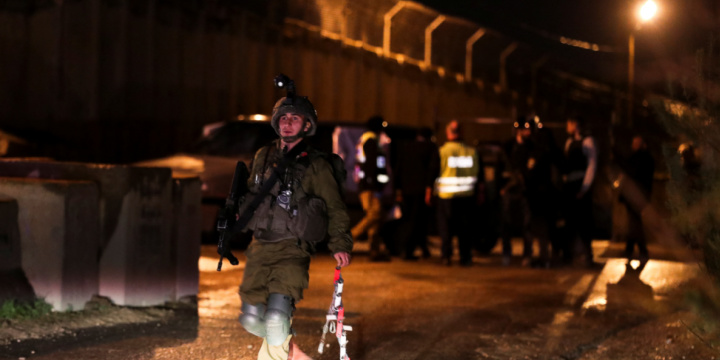
Illustrative: Israeli forces gather at the scene of a shooting attack near a Jewish outpost, near Nablus, in the West Bank, December 16, 2021. REUTERS/Ammar Awad
When Palestinian Authority (PA) police officer and Fatah’s Al-Aqsa Martyrs’ Brigades terror-wing member Younes Walid Shtayyeh shot at Israeli special forces and wounded an Israeli soldier near Nablus, it was not cause for self-scrutiny on behalf of the PA police.
On the contrary, two days later, PA Police Commissioner Allam Al-Saqqa elaborated on the “professional police establishment, which acts as a law enforcement body.” He stressed that the PA police force “maintains security, public order, and morality,” a message the official PA TV reporter summarized by claiming the PA police are “loyal … to the law:”
PA Police Commissioner Allam Al-Saqqa: “[Our progress] emphasizes the integrative relationship between the State Prosecutor’s Office and the [PA] Police, through participation in enforcing justice in the criminal field, which is being protected by a skilled State Prosecutor’s Office that is striving to strengthen the rule of law, alongside a professional police establishment, which acts as a law enforcement body, operates in coordination with the State Prosecutor’s Office and under its supervision, maintains security, public order and morality, and fulfills its role within the framework of the law” … [emphasis added]
[Official PA TV News, Nov. 22, 2025]
According to PA ideology, there really is no contradiction between trying to murder Israelis and maintaining the law. Fatah and Hamas alike glorified the “operation” of police terrorist Shtayyeh, and after he was killed by Israeli forces, social media overflowed with praise for him.
Palestinian Media Watch has documented the double role of the PA police and Security Forces as cops by day — and terrorists by night — many times, recently in the report, Terrorists in Uniform.
Fatah’s terror wing announced with “pride and glory” that Shtayyeh’s funeral was a “wedding” and stressed that the PA police officer died while “fulfilling the duty of struggle and engaging in armed confrontation with enemy.”
The Al-Aqsa Martyrs’ Brigades also used the opportunity to pledge to continue “the path of struggle” until “the removal” of the State of Israel:
Posted text: “A military statement by the Al-Aqsa Martyrs’ Brigades
…
Martyr fighter Younes Walid Shtayyeh — one of the fighters of the Al-Aqsa [Martyrs’] Brigades — Nablus
Who ascended to Heaven as a Martyr on Friday, Nov. 21, 2025 … while he was fulfilling the duty of struggle and engaging in armed confrontation with enemy …
The Al-Aqsa Martyrs’ Brigades, while accompanying the Martyr commander to the wedding, pledge before Allah that their fighters will continue … on the path of struggle and resistance, until the removal of the occupation from our land and our occupied holy sites.This is a revolution until victory!
The Al-Aqsa Martyrs’ Brigades – Palestine
The military wing of the Fatah Movement
Saturday… Nov. 22, 2025″ [emphasis added][Al-Aqsa Martyrs’ Brigades, Telegram channel, Nov. 22, 2025]
Fatah political officials paid condolence visits to the family, while Fatah’s terror wing described the police terrorist as a “heroic Martyr”:
Posted text: “Fatah Movement Nablus District Secretary Muhammad Hamdan ‘Abu Al-Mutaz’ and members of the district committee in a visit of blessing and condolences on the ascent to Heaven of heroic Martyr Younes Walid Shtayyeh.” [emphasis added]

The terrorist’s father praised his death as a “Martyr,” saying it was “anticipated” and that Allah “chose him”:
Father of terrorist Younes Walid Shtayyeh: “Younes… there is no one who doesn’t love him… May Allah have mercy on him [and] be pleased with him … He asked for [Martyrdom] and achieved it.
We anticipated this … We consider him a Martyr with Allah. .. The [Israeli] army’s special forces besieged the area … He took his weapon and went out, he fought them outside and fell as a Martyr … All this is the decree of Almighty Allah. Our Lord chose him [to be a Martyr].” [emphasis added]
[“Nablus News,” Telegram channel, Nov. 22, 2025]
A Hamas-affiliated network honored the terrorist, sharing a video of him posing with and firing an assault rifle, while a song played in the background:
Song lyrics: “Do not mourn, for eternal life awaits us
Shed no tears, for Paradise is the appointed meeting place
I sacrifice myself to meet Allah, for the sake of life [in Paradise] and [Allah’s] satisfaction”Posted text: “Images of [PA] police officer Martyr Younes Shtayyeh, the one who carried out the shooting operation on the occupation soldiers while they were making arrests in Nablus a few days ago. [An operation] in which he ascended to Heaven while confronting an Israeli Yamam force.” [emphasis added]
[Quds News Network (Hamas), Telegram channel, Nov. 22, 2025]
The “Al-Quds Brigades – Grandchildren of Glory,” Islamic Jihad’s terror wing, posted pictures of the terrorist, pointing out he was a police officer:

Posted text: “[PA] police officer Martyr Younes Walid Shtayyeh, whom the occupation (i.e., Israel) accuses of shooting at its forces during the raid on Nablus yesterday”
[“Al-Quds Brigades – Grandchildren of Glory,” Telegram channel, Nov. 21, 2025]
Other groups applauded terrorist Shtayyeh as a “Jihad fighter” and stressed that he was “a son of the Fatah Movement. A son of the Palestinian Security Forces”:

The author is a contributor to Palestinian Media Watch, where a version of this story first appeared.
Uncategorized
An idyllic Jewish village, full of life and hope, just hours before its utter annihilation
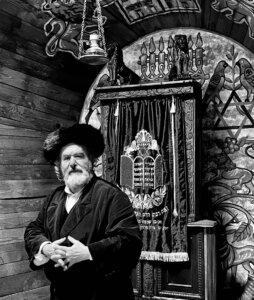
A remarkable scene in Ady Walter’s film Shttl takes place in a Jewish Ukrainian village outside of Kiev on June 21, 1941, one day before the Nazi invasion, known as Operation Barbarossa.
The Rebbe, played by the always excellent Saul Rubinek is the voice of reason; he is a thoughtful, complex, contradictory and conflicted character. He does not raise his voice, he takes time to consider what to say as he himself struggles to respond to whatever factionalism arises within the community. His sad eyes are expressive. He repeatedly rubs his thumb across his fingers. This is a master class in consummate acting.
The mostly black-and-white Yiddish language film, currently playing in New York at New Plaza Cinemas, spans 24 hours in the shtetl, whose residents remain clueless of the impending doom despite the presence of the Russian Army that has already infiltrated the village. Nonetheless the cracks are surfacing within the community. Intense arguments abound on such issues as workers rights and whether to abandon religion or commit to a devoted life. One female character espousing the need for women’s rights, anticipates the future struggle of feminism in the face of patriarchy.
At its core, the film explores Jewish identity, unity and survival. The Rebbe understands factionalism yet remains implacable as he urges the townspeople to be Talmudic in their judgments, tolerant and compassionate. He describes true Jewishness as the color gray, allowing for and even respecting differences of opinion, purpose and worldview.
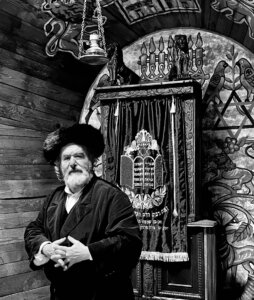
For, the Rebbe, Jews must always remain unified on some profound level. “Unity is the only thing that matters in the battle against evil,” he asserts. His second tenet is faith in God. Doubt can never enter the picture.
The central character, Mendele (Moshe Lobel in a nicely understated performance) is an aspiring filmmaker, who has long since left the shtetl to join the Red Army in Kyiv. But he returns home along with his best friend, a non-Jewish Ukrainian named Demyan (Petro Ninovskyi), so he can elope with his true love, Yuna (Anisia Stasevich), the child of The Rebbe.
But Yuna is already engaged through an arranged marriage to Folie (Antoine Millet), a cruel, autocratic Hasid who, despite his alleged religiosity, is petty, sly, cunning and ultimately violent.
Mendele remains torn between his ambitions embodied by the cosmopolitan outside world and the restrictive, confined shtetl where he is still deeply rooted. And he can’t help but feel connected to his estranged father, whom he holds responsible for the suicide of his late mother who, like Mendele, was also an outlier.
The film was shot in Ukraine in 2021 at the height of COVID-19 restrictions and at the very moment the Russian invasion was looming. The set, including a synagogue, was supposed to be converted into a museum honoring Ukraine’s Jewish past. But in the end, the Russian forces destroyed the whole shtetl set and the land was mined. Now that the president of Ukraine is a Jew at the very same time antisemitism is surging across the globe and Ukrainians and Jews are both under assault, the parallels and irony are almost implausible.
Walter, a documentary film director making his feature debut, has said his mission was to bring the shtetl universe that was totally wiped out during the Holocaust back to life. The title Shttl with its missing “e” references the 1969 novel, La Disparition by Georges Perec, whose mother died in Auschwitz. In Perec’s fictional work the letter “e” never appears in Shttl, its absence mirroring the emptiness, the void, the loss.
In this film, unlike such Holocaust classics like Schindler’s List, The Pianist, Son of Saul, death, despair, and hopelessness are not yet part of the collective experience. This is life prior to the Holocaust in an ethnically diverse community overflowing with purpose and hope for the future. Many Jews and gentiles enjoy camaraderie, and Yiddish and Ukrainian are both spoken.
Shtll’s cinematic technique is evocative, specifically the way scenes of recollection seamlessly morph into color — Mendele recalls his life as a yeshiva boy and the time his gentle mother gave him a baby rabbit as a pet. The colorful flashbacks suggest the past is so much more vivid than the black-and-white present.
Nevertheless, I found the film problematic. Though it has been praised for its one-shot cinematic approach, which purports to make the movie more immediate, real and immersive for the viewer, the set and the inconsistent performances made it feel more like a filmed stage play to me. And, more importantly, the characters don’t seem like actual human beings as they do spokespersons for various political, philosophical,and religious viewpoints. The quirky folkloric figures don’t help. There are two holy fools of various stripes — a beatific deceased mom who appears as a spectral figure, and my favorite, the butcher who has become a vegetarian.
Admittedly, my image of shtetl life is informed by a Fiddler on the Roof ethos and, by extension, the stories of Sholem Aleichem which presents a largely impoverished, insular and marginalized world, even if its residents don’t see themselves as disenfranchised. But in Shtll, the youthful characters are self-confident in their speech, gestures, and especially their wide-stride, swaggering gaits. They seemed jarringly secular and contemporary to me.
In one scene, our three protagonists, including Yuna, are happily passing back and forth a bottle of booze, each guzzling from the communal cap. The provincial virginal daughter of The Rebbe in a 1941 shtetl? Really?
In the end, though, the film makes a 180-degree turn that nearly eradicates its flaws. Mendele, Demyan, and Yuna have spent the night in the forest and have fallen asleep content in their certainty that at sunrise they will be embarking on their great adventure to freedom.
As dawn breaks and the sun begins to emerge over the trees. Mendele hears gunfire and spies the battalions of Nazis entering the shtetl en masse. The obliteration that will follow is clear. The respective politics, philosophies, not to mention petty jealousies, indeed, all the internecine fighting on the one hand and the moments of jubilation on the other have become totally meaningless. The realization is devastating.
The post An idyllic Jewish village, full of life and hope, just hours before its utter annihilation appeared first on The Forward.





